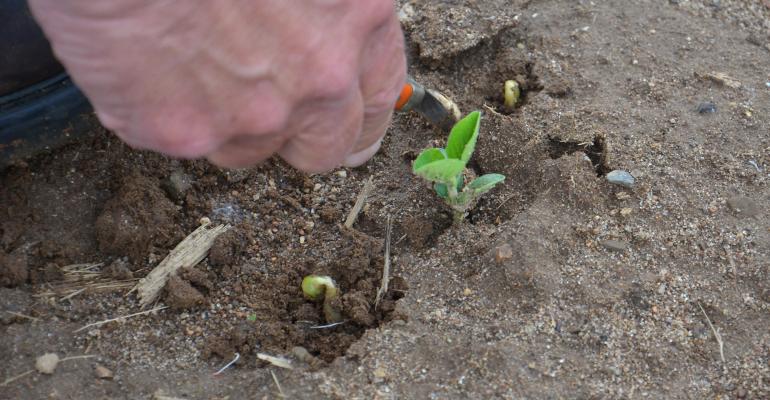Scout for early-season soybean diseases

Soybean Pest Beat: Here are soybean diseases to watch for especially through June.
Apr 30, 2019
Which diseases should I be scouting for throughout June in soybeans? Which ones can I do something about? What can I do?
The Indiana certified crop advisers answering this question are Jamie Bultemeier, A&L Great Lakes Labs, Fort Wayne; Troy Jenkins, agronomist with Ceres Solutions, Rochester; and Marty Park, Great Lakes Seed Service, Rensselaer.
Bultemeier: In early to mid-June, scout for seedling blights, phytophthora, rhizoctonia root rots, brown spot, white mold, bacterial leaf blight and sudden death syndrome. Late June starts the window for frogeye leaf spot. This disease can lead to yield loss when a significant portion of the leaf is covered with lesions, and may warrant a fungicide application.
Track brown spot throughout the growing season. If the leaf coverage continues to increase through pod formation, a fungicide treatment may be warranted during R3 to R5. Fungicide treatment of white mold is not as effective as cultural methods of using wider row spacing and lower plant populations.
The main treatment for the rest of these diseases lies in variety selection and cultural practices. Identifying fields where these diseases reside aids in future seed variety selection and management.
Jenkins: Two of the earliest observed diseases, pythium and phytophthora, are caused by water molds in poorly drained soils. Infection can occur around germination, and plants damp off. Seed treatments are the best method of disease prevention for Pythium, while selection of resistant varieties along with fungicide seed treatment is best for phytophthora.
Another early-season disease is rhizoctonia root rot. Seen usually on hills or side slopes, plants develop brick-red, sunken lesions at the soil line. Plants become pale and stunted, and have poor root systems. The proper choice of fungicide seed treatment provides the best control.
Sudden death syndrome infests soybean roots at or shortly after germination. Conditions for infection are cool, wet, tight soils. Disease inoculum survives in both soybean and corn residue. Integrated management strategies of improving soil drainage, using more resistant varieties, maintaining good fertility, delaying planting date until soil is warmer and using a fungicide seed treatment that includes Ilevo can help combat this disease.
Sclerotinia white mold is a common fungal disease seen in northern regions. A fungicide applied at or before first flower, followed by a second application later, provides partial control. Use of resistant varieties has been limited.
Bacterial leaf blight is an early-season bacterial disease that survives in plant residues. Infection can start early on cotyledons and unifoliate leaves as small, angular, reddish-brown spots surrounded by yellow halos. Using more tolerant varieties is recommended
Brown spot is one of the most common early-season foliar diseases. The disease starts in the bottom part of the canopy as purple lesions on unifoliate leaves. Lesions on trifoliate leaves are dark brown and irregularly shaped. Heavily infected leaves turn yellow and drop off. Crop rotation is a management method. Foliar fungicides applied at R3 are effective.
Park: When you are scouting for weed control, look for early disease development. Check the heavier areas in the field and look for plants dying from phytophthora. Look for brown spot in the lower crop canopy. It’s normally not an economic problem.
Start looking for circular angular spots on leaves caused by frogeye leaf spot with the amount we saw last year. Knowing disease pressure now and then checking it again near the R2 stage will help determine if a fungicide application will be warranted.

